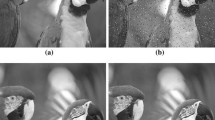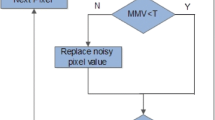Abstract
Day-by-day impulse detection seems critical because removing the random-valued impulse noise with high density from the noisy image is a typical task. The specified noise does not regularly obstruct the pixels of the image. The proposed work, which combines self-organizing migration & adaptive dual-threshold techniques, gives optimal output for the noisy image in less time. The proposed methodology has been applied on various noisy images with different window sizes and it has proven better results while reconstructing the original image with high quality from the noisy image. To evaluate the performance of the proposed work MSE and PSNR has considered as evaluation parameters. PSNR value is evaluated by varying the noise from 10 to 70%. As per the comparative analysis, it is proved that proposed method gives better results and able to preserve the object information in the given noisy image.










Similar content being viewed by others
References
Parmar, J. M., & Patil, S. A. (2013). Performance evaluation and comparison of modified denoising method and the local adaptive wavelet image denoising method. In 2013 International Conference on Intelligent Systems and Signal Processing (ISSP) (pp. 101–105). IEEE.
Zhang, X. (2016). Image denoising using local Wiener filter and its method noise. Optik, 127, 6821–6828.
Kim, B. S., Gil, M. S., Choi, M. J., & Moon, Y. S. (2015). Partial denoising boundary image matching using time-series matching techniques. In 2015 International Conference on Big Data and Smart Computing (BIGCOMP) (pp. 136–141). IEEE.
Liu, J., Wang, Y., Su, K., & He, W. (2016). Image denoising with multidirectional shrinkage in directionlet domain. Signal Processing, 125, 64–78.
Thilagavathi, M., & Deepa, P. (2013). An efficient dictionary learning algorithm for 3d Medical Image Denoising based on Sadct. In 2013 International Conference on Information Communication and Embedded Systems (ICICES) (pp. 442–447). IEEE.
Pan, Q., Zhang, L., Dai, G., & Zhang, H. (1999). Two denoising methods by wavelet transform. IEEE Transactions on Signal Processing, 47(12), 3401–3406.
Jones, C. B. (2017). Cyber-security and combatting cyber-attacks: A study. Journal of Excellence in Computer Science and Engineering, 3(2), 1–16.
Gonzalez, R. C., & Woods, R. E. (2002). Digital image processing. Prentice-Hall.
Lan, X., & Zuo, Z. (2014). Random-valued impulse noise removal by the adaptive switching median detectors and detail-preserving regularization. Optik, 125(3), 1101–1105.
Wang, Z., & Zhang, D. (1999). Progressive switching median filter for the removal of impulse noise from highly corrupted images. IEEE Transactions on Circuits and Systems II: Analog and Digital Signal Processing, 46(1), 78–80.
Anupriya, A., & Tayal, A. (2012). Wavelet-based image denoising using self-organizing migration algorithm. CIIT International Journal of Digital Image Processing, 4(10), 542–546.
Zongang, L., & Tong, W. (2015). An adaptive image denoising algorithm based on wavelet transform and independent component analysis. In 2015 Sixth International Conference on Intelligent Systems Design and Engineering Applications (ISDEA) (pp. 104-107). IEEE. https://doi.org/10.1109/ISDEA.2015.36.
Deng, X., & Liu, Z. (2015). An improved image denoising method applied in resisting mixed noise based on MCA and Median filter. In 2015 11th International Conference on Computational Intelligence and Security (CIS) (pp. 162–166). IEEE. https://doi.org/10.1109/CIS.2015.47.
Liu, X., Tanaka, M., & Okutomi, M. (2013). Single-image noise level estimation for blind denoising. IEEE Transactions on Image Processing, 22(12), 5226–5237.
Raja, R., Sinha, T. S., Patra, R. K., & Tiwari, S. (2018). Physiological trait-based biometrical authentication of human-face using LGXP and ANN techniques. International Journal of Information and Computer Security, 10(2–3), 303–320.
Gupta, V., Chaurasia, V., & Shandilya, M. (2015). Random-valued impulse noise removal using adaptive dual threshold median filter. Journal of Visual Communication and Image Representation, 26(296), 304.
Zelinka, I. (2014). SOMA—self-organizing migrating algorithm. New optimization techniques in engineering (pp. 167–217). Springer.
Kadlec, P., & Raida, Z. (2011). A novel multi-objective self-organizing migrating algorithm. Radioengineering, 20(4), 1–13.
Malini, S., & Moni, R. S. (2015). Image denoising using multiresolution analysis and nonlinear filtering. In 2015 Fifth International Conference on Advances in Computing and Communications (ICACC) (pp. 387–390). IEEE.
Qi, X., Liu, B., & Jianwei, Xu. (2016). A neutrosophic filter for high-density salt and pepper noise based on pixel-wise adaptive smoothing parameter. Journal of Visual Communication and Image Representation, 36, 1–10.
Xu, J., Jia, Y., Shi, Z., & Pang, Ke. (2016). An improved anisotropic diffusion filter with the semi-adaptive threshold for edge preservation. Signal Processing, 119, 80–91.
Wang, J., Guo, Y., Ying, Y., Liu, Y., & Peng, Q. (2006). Fast non-local algorithm for image denoising. In 2006 International Conference on Image Processing (pp. 1429–1432). IEEE.
Ito, S., & Yamada, Y. (2003). Multiresolution image analysis using dual Fresnel transform pairs and application to medical image denoising. In Proceedings 2003 International Conference on Image Processing (Cat. No. 03CH37429) (Vol. 1, pp. I-557). IEEE.
Thote, B. K., & Jondhale, K. C. (2016). Improved denoising technique for natural and synthetic images. In 2016 International Conference on Signal and Information Processing (IConSIP) (pp. 1–4). IEEE.
Brito-Loeza, C., & Chen, Ke. (2010). On high-order denoising models and fast algorithms for vector-valued images. IEEE Transactions on Image Processing, 19(6), 1518–1527.
Strauss, D. J., Teuber, T., Steidl, G., & Corona-Strauss, F. I. (2012). Exploiting the self-similarity in ERP images by nonlocal means for single-trial denoising. IEEE Transactions on Neural Systems and Rehabilitation Engineering, 21(4), 576–583.
Balster, E. J., Zheng, Y. F., & Ewing, R. L. (2005). Feature-based wavelet shrinkage algorithm for image denoising. IEEE Transactions on Image Processing, 14(12), 2024–2039.
Barbu, T. (2016). A nonlinear fourth-order PDE-based image denoising technique. In 2016 International Conference on Systems, Signals and Image Processing (IWSSIP) (pp. 1–4). IEEE.
Gajbhar, S. S., & Joshi, M. V. (2013). Image denoising using redundant finer directional wavelet transform. In 2013 Fourth National Conference on Computer Vision, Pattern Recognition, Image Processing and Graphics (NCVPRIPG) (pp. 1–4). IEEE.
Rani, S., Lakhwani, K., & Kumar, S. (2022). Three dimensional objects recognition & pattern recognition technique; related challenges: A review. Multimedia Tools and Applications, 81, 1–44.
Rani, S., Ghai, D., & Kumar, S. (2021). Construction and reconstruction of 3D facial and wireframe model using syntactic pattern recognition. Cognitive Behavior and Human Computer Interaction Based on Machine Learning Algorithm, 2021, 137–156.
Rani, S., Ghai, D., & Kumar, S. (2022). Reconstruction of simple and complex three dimensional images using pattern recognition algorithm. Journal of Information Technology Management, 14, 235–247.
Rani, S., Kumar, S., Ghai, D., & Prasad, K. M. V. V. (2022). Automatic Detection of brain tumor from CT and MRI images using wireframe model and 3D alex-net. In 2022 International Conference on Decision Aid Sciences and Applications (DASA) (pp. 1132–1138). IEEE.
Rani, S., Ghai, D., Kumar, S., Kantipudi, M. V. V., Alharbi, A. H., & Ullah, M. A. (2022). Efficient 3D AlexNet architecture for object recognition using syntactic patterns from medical images. Computational Intelligence and Neuroscience, 2022, 7882924.
Rani, S., Ghai, D., & Kumar, S. (2021). Reconstruction of wire frame model of complex images using syntactic pattern recognition. IET Digital Library, 2021, 8–13.
Kumar, S., Jain, A., Kumar Agarwal, A., Rani, S., & Ghimire, A. (2021). Object-based image retrieval using the U-Net-Based neural network. Computational Intelligence and Neuroscience, 14, 1–16.
Raja, R., Sinha, T. S., & Dubey, R. P. (2015). Recognition of human-face from side-view using progressive switching pattern and soft-computing technique. Association for the Advancement of Modelling and Simulation Techniques in Enterprises, Advance B, 58(1), 14–34.
Sinha, T. S., Patra, R., & Raja, R. (2011). A comprehensive analysis of human gait for abnormal foot recognition using neuro-genetic approach. International Journal of Tomography and Statistics, 16(W11), 56–73.
Raja, R., Patra, R. K., & Sinha, T. S. (2017). Extraction of features from dummy face for improving biometrical authentication of human. International Journal of Luminescence and Application, 7(3–4), 507–512.
Kumar, S., Singh, S., & Kumar, J. (2018). Live detection of face using machine learning with multi-feature method. Wireless Personal Communications, 103, 2353–2375. https://doi.org/10.1007/s11277-018-5913-0
Kumar, S., Singh, S., & Kumar, J. (2018). Automatic live facial expression detection using genetic algorithm with Haar wavelet features and SVM. Wireless Personal Communications, 103, 2435–2453. https://doi.org/10.1007/s11277-018-5923-y
Srikrishnaswetha, K., Kumar, S., & Johri, P. (2018). Comparision study on various face detection techniques. In 2018 4th international conference on computing communication and automation (ICCCA) (pp. 1–5). IEEE.
Meher, S. K. (2014). Recursive and noise-exclusive fuzzy switching median filter for impulse noise reduction. Engineering Applications of Artificial Intelligence, 30, 145–154.
Author information
Authors and Affiliations
Corresponding author
Additional information
Publisher's Note
Springer Nature remains neutral with regard to jurisdictional claims in published maps and institutional affiliations.
Rights and permissions
Springer Nature or its licensor (e.g. a society or other partner) holds exclusive rights to this article under a publishing agreement with the author(s) or other rightsholder(s); author self-archiving of the accepted manuscript version of this article is solely governed by the terms of such publishing agreement and applicable law.
About this article
Cite this article
Kumar, S., Raja, R., Mahmood, M.R. et al. A Hybrid Method for the Removal of RVIN Using Self Organizing Migration with Adaptive Dual Threshold Median Filter. Sens Imaging 24, 9 (2023). https://doi.org/10.1007/s11220-023-00414-9
Received:
Revised:
Accepted:
Published:
DOI: https://doi.org/10.1007/s11220-023-00414-9




